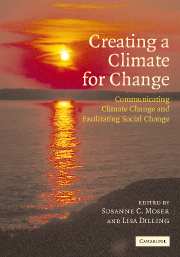Book contents
- Frontmatter
- Contents
- Preface
- Foreword
- List of contributors
- List of tables
- List of figures
- List of text boxes
- Introduction
- Part I Communicating climate change
- 1 Weather or climate change?
- 2 Communicating the risks of global warming: American risk perceptions, affective images, and interpretive communities
- 3 More bad news: the risk of neglecting emotional responses to climate change information
- 4 Public scares: changing the issue culture
- 5 The challenge of trying to make a difference using media messages
- 6 Listening to the audience: San Diego hones its communication strategy by soliciting residents' views
- 7 The climate-justice link: communicating risk with low-income and minority audiences
- 8 Postcards from the (not so) frozen North: talking about climate change in Alaska
- 9 Climate change: a moral issue
- 10 Einstein, Roosevelt, and the atom bomb: lessons learned for scientists communicating climate change
- 11 Across the great divide: supporting scientists as effective messengers in the public sphere
- 12 Dealing with climate change contrarians
- 13 A role for dialogue in communication about climate change
- 14 Information is not enough
- Part II Facilitating social change
- Part III Creating a climate for change
- About the authors
- Index
- References
13 - A role for dialogue in communication about climate change
Published online by Cambridge University Press: 20 August 2009
- Frontmatter
- Contents
- Preface
- Foreword
- List of contributors
- List of tables
- List of figures
- List of text boxes
- Introduction
- Part I Communicating climate change
- 1 Weather or climate change?
- 2 Communicating the risks of global warming: American risk perceptions, affective images, and interpretive communities
- 3 More bad news: the risk of neglecting emotional responses to climate change information
- 4 Public scares: changing the issue culture
- 5 The challenge of trying to make a difference using media messages
- 6 Listening to the audience: San Diego hones its communication strategy by soliciting residents' views
- 7 The climate-justice link: communicating risk with low-income and minority audiences
- 8 Postcards from the (not so) frozen North: talking about climate change in Alaska
- 9 Climate change: a moral issue
- 10 Einstein, Roosevelt, and the atom bomb: lessons learned for scientists communicating climate change
- 11 Across the great divide: supporting scientists as effective messengers in the public sphere
- 12 Dealing with climate change contrarians
- 13 A role for dialogue in communication about climate change
- 14 Information is not enough
- Part II Facilitating social change
- Part III Creating a climate for change
- About the authors
- Index
- References
Summary
Introduction
While many controversies are resolved through analysis, argument, compromise, and resolution, some become defined instead by opposing views that cluster around seemingly irreconcilable poles. This is the case, for example, in debates currently taking place in many communities around the dilemma of climate change and proposed responses. Under these conditions, approaches that work successfully in other contexts often become perversely counterproductive. Argument degenerates into diatribe, discussions deteriorate into shouting matches. Compromise becomes seen as surrender and a widely acceptable solution becomes hard to imagine (Becker et al., 1995).
Given the challenges current conversations about climate change present, how do we begin a new and different conversation, or re-engage without rancor? A communication technique appropriately enough called dialogue offers one approach. Although dialogue is not conflict resolution, neither is it “just talk.” It invites a conversation rooted in participants' personal experience. It can help to ease strained relationships and establish new ones. The new connections can themselves lead to new ways of understanding contentious issues like climate change and to discussing and developing possible solutions.
Dialogue is a genuinely creative and generative act. Successful dialogue is sometimes simply a willingness to meet again to continue talking, but once people begin to speak honestly about their concerns, and about their own uncertainties with regard to their deeply held positions, ideas for next steps emerge that could not have been imagined before the dialogue. Success can also be a decision to take an action that was previously not imagined or thought possible.
- Type
- Chapter
- Information
- Creating a Climate for ChangeCommunicating Climate Change and Facilitating Social Change, pp. 213 - 222Publisher: Cambridge University PressPrint publication year: 2007
References
- 10
- Cited by



